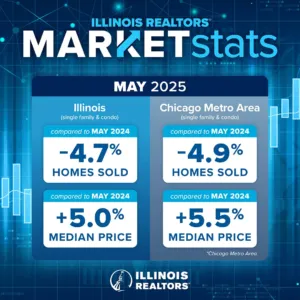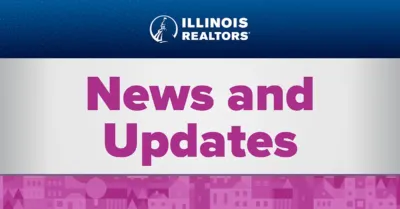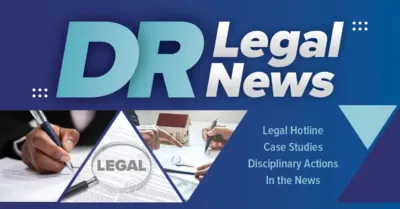Legal Case Studies: September 2023
Legal case studies in this issue:
- Neighbors’ intentional interference with easement ends with injunction
- Both parties’ material breaches allow both to recover money damages
- Lack of proper service causes reversal of tax deed sale
- “Spot-zoning” challenge to pre-annexation agreement fails
- Voluntary dismissal of PTAB appeal not a barrier to property tax objection proceeding

Neighbors’ intentional interference with easement ends with injunction
Downing v. Somers, 2023 IL App (4th) 220900
In 1981, George and Bess White (the “Whites”) purchased 2.45 acres of real property in McLean County, Illinois, including an access easement (“Easement”) included on a deed conveying them the property. From 1981-2005, either the Whites or their tenant farmer used the Easement to access farmland. In 1990, William and Shari Somers (the “Somers”) purchased a homestead bordering the Whites’ property and Easement. The Somers knew the Easement existed prior to their purchase in 1990, and 15 years later, when purchasing 60 acres of real property surrounding their home.
In 2005, the Somers’ attorney wrote to James Downing (“Downing”), as trustee to a certain Trust, who held title to that 2.45 acres previously held by the Whites, seeking release and waiver of the Easement. Downing refused. The Somers still purchased the 60 acres, and the deed conveying the land identified the Easement, excepting it from the purchase. Almost immediately after purchasing the 60 acres, the Somers began interfering with Downing’s use of the Easement, specifically by disking the land, and later planting grass and trees, further impeding access to the Easement.
Downing complained about these obstructions, which the Somers briefly removed before erecting fencing over the Easement as part of a horse corral, again impeding access. Downing again objected, asking for the corral’s removal so that the Trust and/or its tenant farmer could use the Easement to access farmland. The Somers refused and resumed planting vegetation across the Easement. From 2007, through 2020, Downing and the Trust’s tenant farmer had no way to travel across the Easement because of those obstructions placed by the Somers, requiring them to access the farmland by other means.
In 2021, Downing filed a 2-count lawsuit against the Somers. Count I sought declaratory judgment that Downing was entitled to the Easement, definition of the easement’s “extent and parameters” and removal of all obstructions erected by the Somers. Count II sought a permanent injunction, requiring the Somers to dismantle and remove the existing obstructions on the Easement, and restore its as a way of Downing and/or the tenant farmer to access the farmland, and further prohibit the Somers from placing obstructions in the Easement. The Somers answered Downing’s Complaint with 2 affirmative defenses, abandonment and laches, and a counterclaim seeking declaratory judgment that their use was not “an unreasonable obstruction” to Downing’s use of the Easement, and that Downing’s actions were “an unlawful attempt” to expand the Easement’s scope.
Downing moved for summary judgment, attaching his tenant farmer’s affidavit, certain excerpts from the Somers’ depositions, the original deed granting the Whites the Easement, the letter from the Somers’ attorney to Downing asking for the Easement’s release, and a letter from Downing’s attorney asking for the obstructions’ upon the Easement’s to be removed. The Somers opposed summary judgment, arguing that genuine issues of material fact existed, citing to certain portions of their own, and others, depositions and affidavits. Following a hearing on Downing’s motion for summary judgment, the trial court ruled for Downing, finding that the Easement was created by the White’s original deed, and when the Somers purchased the certain 60 acres in 2005, they were “fully aware” of the Easement, evidenced by their attorney seeking its release. The court went on to find that the Someres thereafter “engaged in a pattern” of obstructing Downing’s use of the Easement and were aware that they could not lawfully “block” Downing from its use and access, but chose to do so by various methods, granting Downing’s motion for summary judgment.
The trial court issued an order declaring Downing entitled to the Easement, as described within the White’s original deed, and required the Somers to remove their obstructions on the Easement and restore its use of access. The order further prohibited the Somers from obstructing Downing’s use of the Easement, or committing any acts or conduct to obstruct Downing’s access of the Easement, and denied the Somers’ counterclaim. The Somers filed a Motion to Reconsider, arguing that the trial court misapplied the law by granting summary judgment, and that its order deprived them of the use of their land, effectively giving Downing ownership of the Easement and the Somers an easement over their own land. After a hearing on the Somers’ Motion to Reconsider, the trial court issued a new order, reiterating its prior findings, and rejecting the Somers’ argument that they did not “intentionally” obstruct Downing’s use of the Easement, and elected to not consider the “reasonableness” of the Somers’ actions, instead finding that the Somers’ intentionally blocked the Easement, denying the Motion. The Somers appealed to Illinois’ Appellate Court’s Fourth District (the “4th District”).
On appeal, the Somers challenged the trial court’s granting of summary judgment in favor of Downing for 3 reasons: (i) the trial court should have considered the “comparative value” of the Somers’ “desire to safeguard their horses” with the horse corral; (ii) the trial court misapplied the law because their obstructions were “reasonable impediments . . . necessary to keep livestock alive”; and (iii) the trial court’s order “erroneously deprived” the Somers’ use of their land, essentially giving Downing ownership of the Easement and the Somers an easement across their own land.
Illinois courts may grant motions for summary judgment only if the pleadings, depositions, and any other admissions of file, together with any affidavits, demonstrate that no “genuine issue of material fact” exists, entitling the moving party to judgment as a matter of law. Easements are a right or privilege to the real property of another, best described as “the right to enter, use, or control someone else’s land for a specific, limited purpose.” Easements used to benefit another’s bordering land are generally called an “easement appurtenant.”
“Dominant” and “servient” parcels are necessary to create an easement appurtenant. The “dominant” parcel is the parcel which enjoys the benefit of the easement, and the “servient” parcel is the one bound to the terms of the easement. Here, Downing’s parcel was “dominant” while the Somers was the “servient”; Downing enjoyed the right to use a portion of the Somers’ land for a specific, limited purpose – access to certain farmland via the Easement. Ideally, both the dominant and servient parcels should be able to use the land burdened by the easement appurtenant, however the servient parcel cannot unreasonably interfere with the dominant parcel’s use and enjoyment of the easement. Generally, what amounts to acceptable, or “reasonable,” use by either party depends on the purpose of the easement, when created.
An easement appurtenant “runs with the land,” or burdens the land it exists until terminated or abandoned by the dominant-parcel owner; this is true even if new owners take possession of both the dominant and servient parcels. Here, the Easement continued to exist when the Somers took title to the 60 acres of land subject to it. The original deed granting the Easement labeled it as an “access easement,” which Illinois law generally recognizes as “an easement allowing [1] or more persons to travel across another’s land to get to a nearby location.” Access easements are comparable to a right-of-way, or ingress or egress easements, giving the dominant holder the right to use the servient land to enter and leave its property. The Easement was both an “access” and “ingress-and-egress” easement because it allowed Downing to access a road at one end, while also allowing Downing to enter and exit certain farmland at the other end.
Illinois property law generally entitles the dominant parcel owner to “necessary” use of an easement. Specifically, necessary use of an “access” easement is “unobstructed” use, and for “ingress-and-egress” easements, necessary use includes use of the “full width of the [E]asement area, unhampered by any obstructions.” Any obstructions existing on these easements are generally presumed “unreasonable”; however, “natural” obstructions, like bushes or trees, existing at the time of the easement’s grant, and not otherwise placed there by the servient parcel owner, are the lone exception.
The 4th District first reviewed the Somers’ “comparative value” argument, which essentially argued that the trial court should have balanced the comparative value of the Somers keeping their horses in an enclosure, against the value of Downing using the Easement, without obstruction. Essentially, the Somers argued that the trial court should have first determined whether their blocking the Easement was a “privileged” act before determining whether they acted “intentionally.” “Privileged” conduct is that which protects an interest equal or greater than the opposing party’s interest. The Somers believed their interest in enclosing their horses was of equal, or greater, value than Downing’s interest in accessing farmland. If a party establishes that its conduct is “privileged,” then the other party must prove the conduct was “unjustified” or “malicious.” The Somers argued their actions were privileged, and that because Downing failed to show or plead that their conduct was unjustified or “malicious,” summary judgment was inappropriate. “Privileged” conduct generally applies in cases involving intentional interference with a contract or business advantage.
However, the Somers cited no case where an Illinois court analyzed intentional interference with an easement in the same manner as intentional interference with a contract or business advantage. Rather, Illinois property law determines whether an act was “intentional” based on a whether the party acted with “deliberate” or “willful” disregard for another. An individual’s actions are “deliberate” if made after “due warning” that such actions will violate another’s property right(s); “willful disregard” is a “failure to exercise any appreciable precaution” regarding the property right(s) of another, or “culpable negligence,” including failure to take ordinary and reasonable caution to determine a boundary line.
Applying these principles, the 4th District agreed with the trial court that the Somers intentionally blocked the Easement, because they “clearly knew” of the Easement by seeking its release in 2005. After Downing failed to agree to release the Easement, the Somers began using it “in a manner inconsistent with its character” to access farmland, specifically by disking the land and planting vegetation until Downing objected. Despite Downing’s multiple objections, or “due warnings,” the Somers installed fencing across the Easement to pasture horses, “totally blocking” Downing’s access and use, and refusing Downing’s requests for the fencing’s removal.
The Somers second argument that the trial court misapplied Illinois law because gates across easements are “reasonable impediments” to keep livestock “safe” was also unpersuasive. The Somers argued that the trial court should have considered whether the horse corral was a “reasonable impediment” prior to issuing the injunction. However, Illinois courts, in ruling on matters involving injunctive relief, may decline to balance the equities involved if there is intentional blocking of an easement, because, practically, a finding of intentional interference with an easement neutralizes any “reasonable” use argument, allowing the court to enter injunctive relief without need for a balancing analysis. In their brief, the Somers cited to certain Illinois cases involving easements and gates as obstructions, however, in those cases where gates were found to be “reasonable” obstructions, the easement holder took the easement with those burdens already existing, rather than construction occurring after the easement’s grant. The 4th District also emphasized on Illinois Supreme Court precedent that a servient parcel owner’s use of an easement in a “completely different” use than it was originally devoted is an “unreasonable” use, which the Somers did by disking the land and planting vegetation and fencing the Easement, thus altering its suitability for use as an access easement, and making access by Downing “impossible.”
For these reasons, the 4th District affirmed the trial court’s judgment, in whole.
Both parties’ material breaches allow both to recover money damages
PML Development, LLC, v. Village of Hawthorn Woods, Illinois, 2023 IL 128770
In 2012, the Village of Hawthorn Woods, Illinois (“Village”) and PML Development, LLC (“Developer”) entered into a redevelopment agreement (“Agreement”) providing, among other things, that Developer would import, fill, and bring to grade, a 62-acre parcel of property within the Village (“Property”). The Agreement required Developer to pay taxes on the property until the project was complete, and later donate the land to the Village. The development project faced several challenges during the Agreement’s early term, including the amount of fill on the site, project sequencing, and the ability to acquire certain materials – all issues Developer attributed to the Village.
Illinois contract law requires proof of 4 elements for a party to be entitled to damages: (i) a valid and enforceable contract; (ii) performance; (iii) opposing party’s breach; and (iv) damages. Generally, that party must demonstrate that it performed all its duties and obligations to a contract to sue for damages. Only the other party’s “material” breach excuses a non-breaching party from performing, while still being entitled to damages. Whether the other party’s breach is “material” depends on whether it “defeats the purpose” of why the parties entered the contract. This is generally an issue of fact that will not be overturned on appeal in Illinois unless the trial court’s ruling was “against the manifest weight of the evidence”; a high burden to meet.
Developer filed a breach of contract claim against the Village, alleging those material breaches by the Village affecting Developer’s ability to complete the project on time. The Village responded by filing a counterclaim against Developer for breach of contract, claiming that Developer failed to pay property taxes, resulting in several liens against the property. The trial court found that both parties materially breached the Agreement, and ruled for Developer, finding that its obligations were excused from performance, because of the Village “breached first,” awarding Developer damages in the amount of $268,223.70 resulting from Village’s material breaches.
Village appealed to the Illinois Appellate Court’s Second District (“2nd District”), arguing that because the trial court found that Developer materially breached the Agreement, the Village should have been awarded damages for its counterclaims. The Village also argued that the trial court erred finding that the Village materially breached the Agreement, and Developer should not have been awarded any damages because the Developer breached as well. The 2nd District affirmed the trial court’s finding that the Village materially breached the Agreement by “hindering” Developer’s use of the Property, however, the 2nd District agreed with the Village that the trial court erred in excusing Developer from performance, because any breach by the Village did not relieve Developer from its obligations under the Agreement. Both parties appealed to the Illinois Supreme Court, asking the Court to adopt and apply the “partial breach” doctrine.
Illinois contract law generally requires a party seeking to recover damages under a breach of contract theory to have performed its obligations under the contract. However, the first-to-breach rule will excuse a party’s non-performance if the other party materially breaches its obligations, first; the rule also keeps the party whom “materially breached” from seeking to enforce the non-breaching party’s obligations. This is the reasoning the trial court relied on in excusing Developer’s non-performance, based on the Village’s material breaches of the Agreement. However, the Supreme Court found the trial court’s analysis “flawed” because it did not consider whether Developer accepted benefits from the Agreement, despite the Village’s material breaches. This is because Illinois contract law will not excuse a party from its obligations under a contract if it continues to accept its benefits; the law gives a non-breaching party 2 choices upon another’s material breach: a) continue under the contract, and sue for damages, later; or b) cease performing and sue immediately for damages – it cannot do both. If a party to a contract continues performing after the other’s material breach, it cannot later suspend performance, claiming that it had no duty to perform based on that material breach.
For example, assume a contract between parties provides that if a dispute arises, the parties agree to engage in arbitration or mediation. Assume further that a dispute does later arise, and plaintiffs make demands on defendants to engage in arbitration or mediation, which are refused, and plaintiffs later bring a civil action against defendants, which is stayed after the parties agree to engage in nonbinding mediation. If mediation efforts fail, plaintiffs cannot participate in mediation and later allege in civil litigation that defendants materially breached the contract by initially refusing to engage in arbitration or mediation. This is because Illinois contract law recognizes that if an injured plaintiff continues performing the contract by treating a defendant’s breach as “partial,” then it is bound to this decision and loses the right to stop performance. However, PML Development, LLC, is a case of note because it was the first case before the Illinois Supreme Court discussing the effect of an injured plaintiff’s material breach following the other’s, specifically on the injured plaintiff’s ability to recover damages.
Before addressing this specific question, the Supreme Court looked at both parties’ argument that the 2nd District erred because neither “elected” to continue performing the Agreement after the other’s material breach. Neither party could provide the Court with an Illinois case providing the standard for review, but because the issue of performance is a question of fact and not law, the Court ultimately settled on manifest weight of the evidence standard, which means that the prior court’s decision will not be overturned unless the challengers demonstrate that the court’s decision was against the “manifest weight” of the evidence in the record.
The trial court found that each party accused the other of material breach of the Agreement, yet neither stopped performing their respective obligations, even after Developer filed its lawsuit. The record supported multiple findings of fact regarding occasions where both parties materially breached the Agreement, giving either the opportunity to stop performance and sue, yet neither did, instead continuing performing the Agreement.
In determining that neither party could recover damages because of their material breaches, the 2nd District relied on a 1917 Illinois court decision that did not involve whether both parties continued performing despite the other’s material breach, rather that case involved a seller who “affirmatively” terminated the parties’ Agreement, and as such, the Court found that the 2nd District took the case’s reasoning out of context, and failed to consider whether the Village elected to continue performing despite Developer’s breach.
Because the Court found that both parties elected to continue performing the Agreement, it next considered whether either could recover damages by treating the other’s breach as “partial.” Unlike material breaches, “partial” breaches occur where both parties may be liable to the other for damages. The Court held that the Village materially breached the Agreement, first, by failing to issue proper grading permits, imposing obligations not within the Agreement, and interfering with Developer’s means and methods, and because Developer continued performing, the Village’s breach was “partial,” entitling it to seek damages. The Court found that Developer materially breached the Agreement by failing to: a) convey the Property; b) fund the drawdown account; and c) reconstruct a road. Because the Village continued performing the Agreement, these subsequent material breaches entitled the Village to sue Developer for its damages.
Thus, the 2nd District erred by finding that neither party could recover damages. While the trial correctly entered judgment for Developer, it erred finding for Developer on the Village’s breach of contract counterclaim, and instead should have found for the Village. The Court gave instructions on remand for the trial court to calculate each parties’ damages, and offset the ultimate award given.
At the 2nd District, both parties challenged the trial court’s calculation of Developer’s damages. Developer argued that its damages calculation should be increased, and the Village asserted that Developer failed to prove its damages, and against the trial court’s award of Developer’s attorney fees. The 2nd District failed to consider these arguments, because it stopped its damages analysis after concluding that neither party was entitled to damages. Both parties asked for the Court to remand the issue of damages back to the 2nd District to consider; instead, the Court remanded the issue to the trial court, because it was the trial court entering judgment under the incorrect analysis, and thus failed to make any findings as to the Village’s damages. For this reason, the Court instructed for the trial court to enter a new judgment under the framework provided above, and reconsider its award of Developer’s attorney fees, suggesting the trial court utilize an evidentiary hearing to determine the same.
In sum, the Court reversed the 2nd District’s judgment that neither party was entitled to damages, affirmed the trial court’s judgment for Developer on its breach of contract claims, reversed the trial court’s judgment for Developer on the Village’s breach of contract counterclaims, and remanded the matter back to the trial court for further calculation of the Village’s damages, and offset the ultimate award given.
Lack of proper service causes reversal of tax deed sale
ALW Capital, LLC v. BCL-Peterson Kane, 2023 IL App (1st) 220182
In April 2017, an Acquisitions Company purchased the delinquent property taxes on a certain property located in Chicago, Illinois (the “Medical Property”) owned by a Skilled Care Facility; later that year, the Cook County Clerk issued a certificate of purchase, and the Acquisitions Company delivered a take notice to the Cook County Clerk, as required by the Illinois Property Tax Code (“Property Tax Code”), which provided notice of the total amount required to redeem the property, but failing to include certain Cook County ordinance fees. In November 2017, the Skilled Care Facility acquired the Medical Property via judicial deed.
In May 2018, the Skilled Care Facility filed a statement of change of registered agent and registered office with the Illinois Secretary of State. In December 2018, the Acquisitions Company filed a petition for a tax deed and delivered a take notice to the Cook County Circuit Clerk (the “Clerk”), as required by the Property Tax Code. The Clerk mailed the notice to certain addresses, including that which the Skilled Care Facility filed with the Secretary of State in May 2018.
The Acquisitions Company published notice of the tax sale in the Chicago Tribune for 3 days in December 2018, and sent another take notice to the Cook County Sheriff (“Sheriff”) for service, as required by the Property Tax Code. The Sheriff returned an Affidavit of Service evidencing that this take notice was served on the correct address for service of process, but incorrectly served upon the Skilled Care Facility’s registered agent’s wife, as opposed to properly serving the Skilled Care Facility’s registered agent. Other service attempts at other addresses were completed or attempted by the Sheriff.
In June 2019, the Acquisitions Company sought an Order directing the Cook County Clerk to issue a tax deed, subsequently assigning its rights, title, and interest in the certificate of purchase to an LLC. The trial court granted a motion substituting the LLC as petitioner in place of the Acquisitions Company, and in July 2019, entered an Order directing the Cook County Clerk to issue both a tax deed and Order of Possession to the LLC.
In August 2019, the Skilled Care Facility sought to vacate the trial court’s Order, on 2 grounds: 1) the take notices listed an incorrect redemption amount; and (ii) the Acquisitions Company failed to service notice on several required parties, including the Skilled Care Facility. The Acquisitions Company filed a motion to amend the Order issuing the tax deed based on a typo error in the Medical Property’s legal description, and the trial court entered an amended Order issuing the tax deed but stayed the Order for Possession.
In November 2019, the Skilled Care Facility filed a Motion for Summary Judgment, alleging: 1) the take notices failed to strictly comply with the Property Tax Code because the notices failed to include certain Cook County ordinance fees; and 2) the Acquisitions Company failed to serve notice on the last known tax assessee of record. The Acquisitions Company responsive pleadings argued that the redemption amount was correctly listed, and that the Acquisitions Company properly served notice on the Skilled Care Facility.
The trial court granted summary judgment for the Acquisitions Company on the redemption amount listing issue, the Acquisitions Company service on the last tax assessee of record and denied the cross-motions for summary judgment on the issue of service of notice to the Skilled Care Facility, finding that the Acquisitions Company request for additional discovery indicated an issue of material fact still existed. The Skilled Care Facility filed a motion for the trial court to reconsider its judgment, which was denied.
Discovery commenced in August and October 2021, which depositions revealed that the Skilled Care Facility’s registered agent’s wife could not recall the Sheriff serving her with notice in January 2019, and that she was not involved with the Skilled Care Facility in any official capacity. Other witnesses testified to their recollection of service, one having no familiarity with the entity which the take notice was to be served upon; the other lawfully served.
In November 2021, the Acquisitions Company filed a motion for summary judgment on the issue of service on the Skilled Care Facility, which the Circuit Court granted. The Skilled Care Facility filed a timely appeal in February 2022, to the Illinois Appellate Court’s First District.
On appeal, the Skilled Care Facility argued the Circuit Court erred, and that it was entitled to summary judgment, because: 1) the take notices failed to strictly comply with the Property Tax Code; 2) the Acquisitions Company failed to “diligently” determine, name, and direct notice to certain parties in strict compliance with the Property Tax Code; 3) the Acquisitions Company failed to serve notice on the Skilled Care Facility’s registered agent, as required by the Property Tax Code; and 4) the Acquisitions Company failed to “diligently” determine and direct notice to the Skilled Care Facility’s registered address.
Illinois law allows for motions for summary judgment to be granted where there is no issue of “material fact” when reviewing the facts within the pleadings, affidavits, and other proof on record “in a light most favorable” to the non-moving party. When parties file cross-motions for summary judgment, they agree that only questions of law remain, allowing the court to decide the issues based on the record.
The primary purpose of the Illinois tax deed system is to incentivize tax-delinquent property owners to pay their taxes, not assist others to “deprive” the true owners of right to the property. For this reason, the Property Tax Code requires “strict compliance” with its notice requirements, and assume that lack thereof results in prejudice to the opposing party, and justifies a decision to vacate an tax deed order.
The Property Tax Code specifically requires that a tax purchaser give notice of the tax sale, and date the redemption period expires, to all owners and other parties interested in the property. The Property Tax Code also governs the service of such notices and lists several applicable sections of the Illinois Code of Civil Procedure. The Illinois Code of Civil Procedure regulates service on private corporations like Skilled Care Facility, requiring that a private corporation may be served in Illinois by: 1) leaving a copy of the Complaint and Summons with the corporation’s registered agent, or any corporate officer or agent of found anywhere in Illinois; or 2) in any other manner then, or later, permitted by law. The Illinois Limited Liability Company Act (805 ILCS 180/1-50(a)) requires process to be served upon either limited liability company’s registered agent, or the Illinois Secretary of State.
Here, the Skilled Care Facility’s registered agent was not served notice of the tax sale, instead the Sheriff served notice on its registered agent’s wife who testified in deposition that she had no involvement in Skilled Care Facility’s business operations. After serving notice upon Skilled Care Facility’s registered agent’s wife, the Sheriff never sent notice via certified mail to Skilled Care Facility’s registered agent, and no evidence showed that additional service attempts were made on any other Skilled Care Facility officer or agent.
Acquisitions Company argued that its service upon the registered agent’s wife constituted strict compliance with the Property Tax Code, based on due process arguments, which failed based on the First District’s reliance on the Code’s “strict compliance” requirement.
For these reasons, the First District held that Acquisitions Company failed to strictly comply with the Property Tax Code, therefore the trial court erred granting summary judgment against Skilled Care Facility. The First District reversed the trial court’s judgment, granted summary judgment for Skilled Care Facility, vacated the trial court’s order issuing the tax deed, and remanded the case back to the trial court to calculate Skilled Care Facility’s payment to Acquisitions Company, pursuant to the Property Tax Code.
“Spot-zoning” challenge to pre-annexation agreement fails
Lys v. Village of Mettawa, Illinois, 2023 IL App (2d) 220255-U
In 1998, W.W. Grainger, Inc. (“Grainger”) purchased about 525 acres of unincorporated land within Lake County, Illinois (the “Grainger Property”). Grainger sought and was granted permission from the Lake County Board to rezone and redevelop the Grainger Property; the Lake County (“County”) ordinance granting Grainger’s request limited Grainger to 1.5 million square feet of office space.
The Village of Mettawa (the “Village”), a low-density populated Illinois municipality consisting largely of 5-acre “R-1” single-family estates, bordered the Grainger Property, and filed a lawsuit challenging the County’s rezoning later dismissed via non-judicial settlement that included a provision that Grainger’s first office building on the Property would not exceed 80 feet in height, and no other buildings would exceed 90 feet in height (“Settlement”). Grainger developed the Grainger Property into its corporate campus, including 1 multi-story office building, parking lots, roadways, lighting, drainage improvements, landscaping features, and gated-entrances. In 2014, Grainger built a second building (the “Data Center”).
In 2006, Thomas and Franziska Lys (the “Lys”), purchased nearly 40-acres of land, including a 1320-foot boundary with the Grainger Property (the “Lys Property”). The Lyses received rezoning clearance from Lake County, and redeveloped the Lys Property by building a single-family home, horse stables, and an equestrian facility.
In 2018, the Village annexed about 170-acres of certain unincorporated property within Lake County, including all the developed portion of the Grainger Property. The Village’s annexation ordinance allowed Grainger to enjoy the same development rights as enjoyed under the County’s prior zoning and outlined a future planned unit development (“PUD”), including a rezone and granting of essentially the same variances and permitted uses under the County zoning, including the 1.5 million square foot limit, and building height restrictions.
Grainger applied to the Village for a zoning map amendment to rezone the annexed Property from “R-1” to “O-H” (office/hotel district). Grainger’s PUD petition did not seek to make any changes to the Property but rather to enjoy the same rights enjoyed under the County’s prior zoning ordinance. The Village’s Zoning, Planning, and Appeals Commission (“ZPA”) held 2 public hearings, where several Grainger corporate executives testified that Grainger had approximately 650,000 square footage remaining (within the original 1.5 million restriction), but had no future development plans. A ZPA staff report showed that the Grainger Property had been in continuous operation for over 20 years, and no new changes or development had been proposed. Thomas Lys and his attorney were present for at least 1 of these hearings, and questioned witnesses. The ZPA recommended approval, and the Village adopted the PUD in 2019.
Shortly after the Village’s adopted the PUD, the Lyses filed a 3-count complaint challenging it, seeking declaratory judgment and injunctive relief. Counts 1 and 2, both against the Village, alleged Due Process violations; Count 1 alleged the PUD ordinance was facially unconstitutional, and Count 2 claimed that the ordinance was unconstitutional as applied to the Lyses. Count 3 sought injunctive relief from Grainger related to fencing around the Data Center. The trial court entered summary judgment for the Village on Counts 1 & 2, finding that the Lyses failed to support their Due Process claims, specifically because the ordinance was supported by a “rational basis” to bring the Grainger Property into pre-existing zoning conformity. The trial court did not rule on Count 3.
The Lyses appealed the trial court’s rulings on Counts 1 & 2 to the Illinois Appellate Court’s Second District (“2d District”). On appeal, the Lyses argued that, beginning with the Settlement, the Village’s officials engaged in an impermissible unlawful annexation process involving the Grainger Property. The Lyses argued that under the terms of the Settlement, and annexation and PUD ordinances relating to the Grainger Property, Grainger could redevelop the remaining 650,000 square feet of office space, and potentially construct new structures under heights of 90-feet, absent Village approval, and as such impermissibly “bargained away” the Village’s authority to govern zoning of the Grainger Property. The Village responded that the Lyses’ claims lacked merit, because the annexation ordinance required Grainger to seek Village approval for any future development, and the Lyses failed to show the Village violated their Due Process rights.
The 2d District first addressed whether the Lyses had “standing” to bring their lawsuit; Illinois law generally requires a plaintiff bringing a lawsuit to suffer an “injury” to have standing. The Village argued that because no future development was planned for the Property, the Lyses suffered no injury and lacked standing. The 2d District disagreed, because the Illinois Municipal Code (the “Code”) contains 2 relevant sections giving them standing. First, the Code allows any owner of real property located within 1200-feet of property built or used in violation of a municipal zoning ordinance “substantially affected” by the other property’s violation to institute any appropriate action to “restrain, correct, or abate” said violation. Second, the Code provides that Due Process applies at all stages of decision-making and review of municipal zoning decisions. Both Code sections are designed to give private landowners relief if their municipalities are slow or reluctant to act, or otherwise fail to protect those landowners’ interests in land.
The Lyses alleged that their property valued would be impaired by “hundreds of thousands” of dollars, but lacked any supporting evidence – this lack of evidence was not terminal to the Lyses claims because they also alleged that the Village violated their Due Process rights when approving and adopting the PUD. The 2d District agreed that this gave the Lyses standing but disagreed with them on the merits of their appeal.
Illinois courts grant motions for summary judgment if the pleadings and evidence in the record shows there are no “genuine issues” of material fact, entitling the movant to judgment as a matter of law. Illinois municipal law generally gives municipalities the power to determine the use and purpose which property may be used, and Illinois courts will not reverse their decisions unless a municipality’s actions are found to be “arbitrary or capricious,” or unrelated to the public health, safety, or morals. Unless a municipal ordinance imposes classifications based on factors invoking a higher level of scrutiny, like race or gender, the ordinance is presumed valid, and will be affirmed by a court so long as it satisfies the “rational basis” test. Under the “rational basis” test, the ordinance must be related to a “legitimate legislative purpose” and be reasonable; if a court can find any “rational basis,” the ordinance survives challenge.
Reviewing the record, the 2d District agreed with the trial court that the Lyses failed to provide any evidence that the Village violated their Due Process rights under the rational basis claim, both procedurally, and as applied to the Lyses.
“Procedural” Due Process challenges allege a deprivation of “life, liberty, or property” without notice and an opportunity to be heard. The U.S. Constitution’s procedural Due Process clause generally requires municipalities to provide notice and public hearings regarding potential zoning amendments. Unlawful “spot zoning” occurs where changes in a municipal zoning scheme are applied in small areas, altering the scheme’s “homogeneous, compact, and uniform” nature. “Spot zoning” is unlawful because the municipality essentially “contracts away” its authority and duty to regulate the zoning of that area, for private purposes.
The Lyses received notice of, attended, and participated in, the Village’s public hearings regarding the re-zoning of the Grainger Property. The Lyses were also aware of, but elected not to attend, the Village’s meeting considering and adopting the PUD. This defeated the Lyses procedural Due Process claims, in addition to their claims concerning the valid conditional zoning occurring after those public hearings. The 2d District found that the record demonstrated that the Village and Grainger’s “jointly permitted uses and variations” for the Grainger Property arose from the County’s prior ordinance, which Grainger operated under for 20 years and that the Village ZPA and Village gave “significant consideration” to, and heard evidence concerning, the re-zoning’s impact on the public health, comfort, morals, and welfare. Reviewing the specific language of the re-zoning ordinance, the 2d District found its plain language required Grainger to seek and receive Village approval for any further development.
When a zoning issue is challenged on “substantive” Due Process grounds, Illinois courts rely on the 7 La Salle factors, which must be analyzed based on each case’s unique facts and circumstances. Those factors are: (i) existing uses and zoning of nearby properties; (ii) the extent of diminished property values, if any; (iii) the extent to which diminishing plaintiff’s property values benefits the public “health, safety, morals, or general welfare”; (iv) the relative gain, compared to the hardship imposed; (v) suitability of the subject property for the zoned purposes; (vi) the length of time, if any, the property has been vacant, as considered in the context of the land development within the vicinity of the property; and (vii) the community’s need for the proposed use, and the care the community uses to plan its land use development.
Reviewing the La Salle factors, the 2d District found that: (i) the uses and zoning near the Grainger Property are mostly “residential,” however, the existing use of the Grainger Property was consistent with the Village’s “O-H” classification and not incompatible with nearby properties; (ii) no evidence demonstrated that any property values would be impaired by the zoning; (iii), (iv) there was no evidence of impairment of property value to the Lyses Property by the zoning, rather the zoning merely allowed Grainger to continue operations as it had for the prior 20 years, contributing to the Village’s tax revenue – consequently, any benefit derived from the tax revenue outweighed the lack of evidence of property value impairment to the Lyses; (v) the Grainger Property was suitable to be zoned “O-H”; (vi) the Grainger Property was not vacant; and (vii) throughout the annexation and re-zoning process involving the Grainger Property, the Village “acted with commensurate respect for its land-use process,” and “for the integrity of its comprehensive development plan.”
In sum, the 2d District was unable to find, as a matter of law, that the Village’s re-zoning ordinance failed to comply with the Village’s comprehensive planning, and affirmed the trial court’s judgment with respect to Counts 1 & 2, remanding the case back to the trial court for further proceedings on Count 3.
About the writer:













